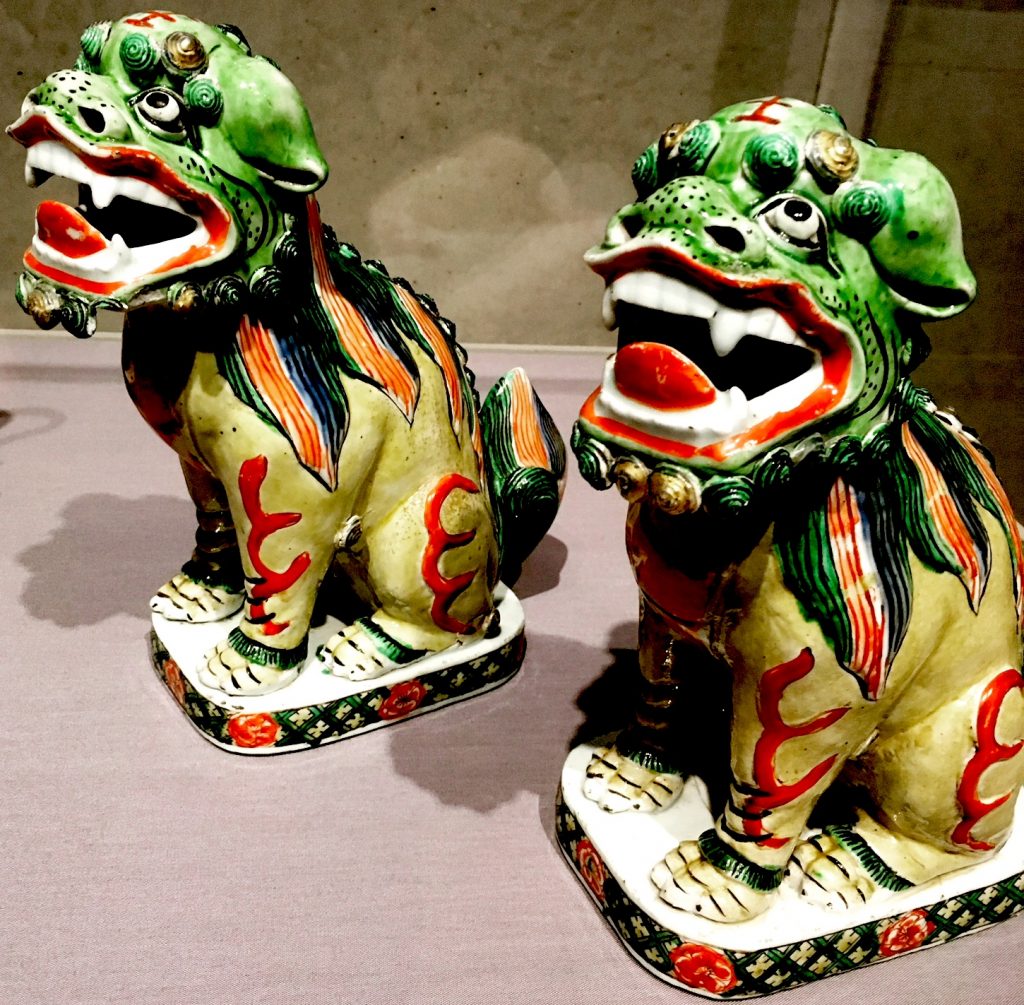
Myers
When I met the man who compiled a priceless collection of Asian art, I was honored and shook his hand quite formally.
When he told me that he bought 60 jade artifacts in a shoebox from a store in Philadelphia for a thousand bucks in the ’70s — including a jade cicada ornament from the second century B.C. — well, I gave him a big ol’ fist bump.
Well played, sir!
“I guarantee you that was a lot of money, back then,” said Sam Myers, the collector who (with his late wife Myrna Myers,) acquired and compiled the works now on display at Fort Worth’s The Kimbell Art Museum.
Wow. That “pick” … er … acquisition I should say, kind of lowered my appreciation for American Pickers and the treasure those guys uncover. The Sam and Myrna Myers Collection contains some of the finest examples of carved jade, painted porcelain, woven silk textiles, forged metals and carved wood “From The Lands of Asia.”

Guardian
The exhibit, virtually filling The Kimbell’s beautiful Renzo Piano Pavilion, opens with elaborate kimonos of embroidered, and even repurposed-fabric garments from courtesans and kabuki performers and more.
The Lands of Asia at The Kimbell

Paisley
Next, “An Ocean of Porcelain” welcomes visitors with dozens of unique vessels from The Ming Dynasty, featuring the elaborate cobalt blue paint, a hue borrowed from Persia, but perfected in Asia. Pottery yes, but, “Very much an art of the brush,” as guests were reminded during a media tour, in preparation of the exhibit opening.
If you look closely over the top, and in the interior of the vases and pitchers, you can see the cracks where broken pieces have been reassembled — most after being salvaged from shipwrecks, reclaimed and restored to seemingly perfection on the exterior.
Perfection.

Porcelain
I must admit that I have never been a big fan of Asian art, and maybe that is why. The perfection. The precision. It’s almost like a mirror to point out my imperfection. When I admire a piece of modern abstract art, I think “maybe I could do that.” When I look at Asian art, I never realized it before, but it is a bit intimidating. The dedication. The perseverance. The discipline. The symmetry.
But in these later years, I have learned to accept that even though I do not always strive for perfection, I can appreciate those who do. It makes me happy that the artists mastered such command of their chosen medium, perhaps achieving their own fulfilment in the process.
The one area where I do look for perfection is Wi-Fi, and of course, The Kimbell has an excellent network. As the tour began, I fired off a shot of two porcelain dragon dogs to Instagram … as I typed notes from the tour on my iPhone … I am sure everyone thought I was being disrespectful to the speakers … prolly chatting … I wasn’t:)

Dragon Dogs
I wondered about the sense of achievement Mr. Myers must feel, having assembled so many memories, great stories and artifacts. It occurred to me that the exhibit could be considered to be a tribute to his beloved Myrna and their travels … their living life to the fullest and collecting.
“Is the exhibit your ‘Taj Mahal,’ constructed with love for your bride,” I asked.
Myers reminded me that Mrs. Myers partnered to build this collection, but added that she would be ecstatic about the success of the presentation at The Kimbell. “Everything here, we did together,” he said.

Bodhisattva Ponders Buddha
As with most art installations, there is a strong spiritual component throughout the works. The more obvious, the multiple Buddhas and Bodhisattvas gracing the halls. But looking closer, the materials used also celebrate divinity. To the Asian cultures, “Jade was everything,” the guide explained. “The stone is most pure. Only the most moral people were worthy of jade.”
Jade cannot be carved with metal. An artisan must use an abrasive combined with countless hours of rubbing or even cutting with a silk string. The majority of the jade pieces in the exhibit are funerary objects or jewelry buried with a loved one or ruler. The Asians, like so many cultures of antiquity, believed that yes, “you can take it with you.”
Among the various symbols in the hall, the dragon is ever-present throughout the pieces … the dragon being the symbol of the emperor. (Interesting to note: officers of the royal court, donned the dragon in various forms, and their rank was expressed with different numbers of claws on the dragon motif.)

Seated Buddha
Although Asian works are the mainstay of the exhibit, there is also a more whimsical little corner of the gallery — “The Cabinet of Wonders” — illustrating the Myers’ fascination with pieces from wherever — Japan, a couple of pieces from Thailand, and even some African art.
There is much attention to porcelain and jade (as described above), but “Silk is the thread that runs through the art of all these lands,” the guide explained, obviously pun intended.
Beyond the kimonos, there was particular interest regarding several framed textiles mounted on a back wall. Did the Asians invent quilting!?! Interesting, Wikipedia doesn’t mention Asian quilting, and yet great examples of the art adorn the wall …
In the Asian examples, there is of course the obvious: meticulous craftsmanship … repetition, geometric sensibilities, silky textures, contrasting colors … but much more than what meets the eye. The printed materials and the guide explained that the quilts are in fact an ancient way of chanting a mantra for enlightenment; a portal to paradise; incorporating numerology to determine horoscopes, and more. Plus they can keep your comrade warm … I digress …

Mystery Discs
Lastly, I asked Myers about the huge, mysterious discs of stone and jade, center-punched by the ancients. No one has the definitive explanation for these interesting discs, some eight-to-ten inches in diameter or so. Ha … The “experts” on some of TV shows in the “Ancient Astronaut” genre are convinced these are some sort of memory storage discs for other-worldly computing … I digress …
More down to earth, Myers deferred to his colleague Felippo Salviati in our little huddle after the tour. Salviati explained that most experts think the discs are portals designed to achieve enlightenment in some sort of religious ritual … or something like that.

Salviati, Myers, Jean-Paul Desroches
I pressed on, trying to get Myers to give his best, educated guess as to the purpose of the objects. He was unsure … but as I talked to him, it became crystal clear to me. Making eye contact with this collector, and noticing the blue-green tint of his well-traveled eyes … it was only then that I realized that the proportions of the discs, related to the hole in their centers, is very much like the colored iris of the human eye, and the portal … the center … the pupil that allows light to reach the mind. Deep, huh?
Myers pondered that for a second and then laughed that the discs had been created at a time when the earth experienced significant warming, many generations ago.
“They were trying to tell us that there are too many cars,” he joked. I’ll have to delve into his book “Two Americans in Paris: A Quest for Asian Art” to see if he expounds on the “ancient Chinese secret” of climate change.
The exhibit at The Kimbell runs March 4 through August 19. And this just in, to commemorate the opening, our friends over at SoulSpace Yoga will get their pose on at the museum with free sessions on Sundays, March 11 through April 22, 11 a.m. to noon. Namaste Ya’ll!
Know what I sayin?


